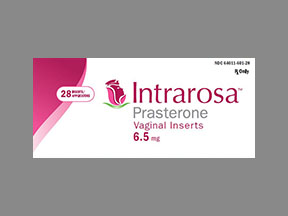
Intrarosa Coupons & Savings Card – Discount Prices from $311.09
My prescription
Edit
6.5MG, Intrarosa (30 Inserts)
Select pharmacy

CVS
$321.28
COUPON PRICE
Walgreens
$311.09
COUPON PRICE
Walmart
$313.24
COUPON PRICE
Albertsons
$316.63
COUPON PRICEFree Intrarosa Savings Card

Walgreens
$311.09
Show this coupon to your pharmacist
ID
LHKPC426419
PCN
GDC
BIN
015995
GRP
DR33
This coupon is not insurance
Related estrogens prescriptions
Related estrogens prescriptions
Price history for Intrarosa
30 Inserts, 6.5MG
Average retail price for Intrarosa
Average SaveHealth price for Intrarosa
Our price history data is based on aggregated prescription data collected from participating pharmacies in America. Our prescription data updates daily to reflect the latest price changes. If you notice a missing data point, it means there wasn't sufficient data available to generate a monetary value for that date.
*Retail prices are based on pharmacy claims data, and may not be accurate when we don't have enough claims.
Intrarosa dosage forms
Dosage Quantity Price from Per unit 6.5MG 30 Inserts $343.27 $11.44 6.5MG 60 Inserts $686.55 $11.44 6.5MG 90 Inserts $1029.82 $11.44
| Dosage | Quantity | Price from | Per unit |
|---|---|---|---|
| 6.5MG | 30 Inserts | $343.27 | $11.44 |
| 6.5MG | 60 Inserts | $686.55 | $11.44 |
| 6.5MG | 90 Inserts | $1029.82 | $11.44 |
Intrarosa Warnings
This document outlines important safety information regarding the use of this medication. It is essential to understand these risks and consult with your healthcare provider if you have any concerns.
Breast Cancer Risk: This medication, Intrarosa (prasterone), transforms into estrogen within the body. Elevated levels of estrogen can increase the risk of breast cancer. The safety of Intrarosa (prasterone) for individuals with a history of breast cancer is not established. It is advised not to use Intrarosa if you currently have or have previously had breast cancer. Regular breast self-examinations and mammograms are recommended. Report any unusual changes in breast shape, size, or color to your healthcare provider without delay.
Contraindications: There are specific conditions under which this medication should not be used due to potential serious health risks. Do not use this medication if you have unexplained vaginal bleeding that has not been evaluated by a healthcare provider. Always consult with your healthcare provider to ensure the medication is safe for you.
Intrarosa Side Effects
When using this medication, some individuals may experience vaginal discharge, which is generally mild but should be reported to a healthcare provider if it persists or worsens. Another potential effect is an abnormal Pap smear, which your healthcare provider will monitor to determine if further tests are necessary. Serious side effects are rare, but they require immediate medical attention. These include signs of an allergic reaction such as rash, itching, hives, or swelling of the face, lips, tongue, or throat. Additionally, if you notice unusual vaginal discharge, itching, an unpleasant odor, vaginal bleeding after menopause, or pelvic pain, seek urgent medical care. While these are the known side effects, always be attentive to any other unusual symptoms and discuss them with your healthcare provider to ensure your safety and well-being.
Intrarosa Interactions
When considering the use of Intrarosa, it's important to be aware of potential interactions with other medications:
Aromatase Inhibitors: Medications like Anastrozole, Exemestane, and Letrozole are used to lower estrogen levels, often in breast cancer treatment. Intrarosa can increase estrogen levels, potentially reducing the effectiveness of these drugs. Therefore, combining Intrarosa with aromatase inhibitors is generally not recommended.
Hormone Replacement Therapies (HRT): The concurrent use of Intrarosa with systemic HRT, including estrogen-only or estrogen-progestogen combinations, has not been studied and is therefore not recommended. This precaution also applies to vaginal estrogen treatments.
Benzodiazepines: Intrarosa may affect the metabolism of certain benzodiazepines, such as Midazolam, potentially leading to increased sedation. If you're using benzodiazepines, consult your healthcare provider before starting Intrarosa.
Latex-Based Contraceptives: Intrarosa can weaken latex materials, so it's advisable to avoid using latex condoms, diaphragms, or cervical caps while undergoing treatment.
While no significant interactions with food or alcohol have been identified, it's essential to inform your healthcare provider about all medications, supplements, and herbal products you're currently using. This ensures a comprehensive evaluation of potential interactions and the safe use of Intrarosa.
What is the purpose of Intrarosa?
Intrarosa is used for the treatment of moderate to severe dyspareunia, which is pain during sexual intercourse, a symptom of vulvar and vaginal atrophy due to menopause. It contains prasterone, which is a synthetic form of dehydroepiandrosterone (DHEA), and helps alleviate symptoms by being converted into estrogen and androgens in the body.
Does Intrarosa increase estrogen levels?
Intrarosa (prasterone) is not known to significantly increase systemic estrogen levels. It is a vaginal insert used to treat moderate to severe dyspareunia, a symptom of vulvar and vaginal atrophy due to menopause. It works locally in the vaginal tissues and is not associated with a significant increase in circulating estrogen levels.
Is Intrarosa better than estradiol?
The choice between Intrarosa (prasterone) and estradiol for treating symptoms of vulvovaginal atrophy in postmenopausal women depends on individual patient needs, preferences, and medical history. Intrarosa is a non-estrogen treatment that may be preferred for those who wish to avoid estrogen. Estradiol, on the other hand, is an estrogen-based treatment that may be more effective for some individuals. It is important for patients to discuss with their healthcare provider to determine the most appropriate treatment option based on their specific circumstances.
Does Intrarosa really work?
Intrarosa (prasterone) is used to treat moderate to severe dyspareunia, a symptom of vulvar and vaginal atrophy due to menopause. Clinical studies have shown that Intrarosa can be effective in reducing the severity of dyspareunia by improving vaginal tissue condition. However, individual responses to the treatment may vary, and it is important for patients to discuss with their healthcare provider to determine if it is the right option for them.
Who should not take Intrarosa?
Intrarosa should not be used by individuals who have undiagnosed abnormal genital bleeding, known or suspected breast cancer, or any other estrogen-dependent neoplasia. Additionally, it should be avoided by those with a known hypersensitivity to any of its components. It is important for individuals to consult with their healthcare provider to determine if Intrarosa is appropriate for their specific medical condition.
